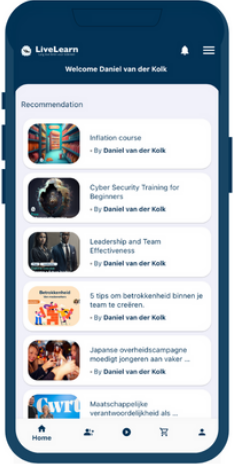
Artikel
16
januari
Building a Bridge Between HR and Food Safety
Training is important for every organization. But for food manufacturers and processors, where one mistake can contaminate hundreds of thousands of pounds of food entering the supply chain, it takes on another level.
These companies have teams of food safety and quality assurance (FSQA) professionals keenly focused on keeping products safe by adhering to numerous food safety standards and regulations. They’re constantly sampling food on the production line for pathogens and allergens. They’re constantly mitigating risks at critical control points and responding to supplier issues and audits. And this only scratches the surface of FSQA responsibilities.
This is why activities such as staffing, onboarding, training, and employee retention aren’t always top of mind for the FSQA team. After all, that’s what HR is for, right? Generally, this might be true, but HR and training are disciplines that can offer widespread value. The best outcomes are a result of cross-department collaboration combining HR and training disciplines with subject matter experts from the range of departments within an organization.
Regarding food safety, research shows motivated and engaged employees are nearly six times more likely to follow food safety protocols consistently, and 17 times more likely to be able to identify and report a food safety risk on the floor (Global Food Safety Training Survey,” Campden BRI, SQF Institute, Intertek Alchemy, et. al., 2022). Now consider that providing more training can increase employee engagement by 30 percent.
Suddenly it seems like onboarding and training are as much a food safety concern as an HR concern. Likewise, employee retention also should be a focus area for FSQA leaders, considering new hires and temporary employees are more likely to make mistakes or encounter issues that can jeopardize food safety.
3 Ways to Leverage the FSQA Team
It could seem daunting for already-busy food safety leaders to realize they should play a more active role in onboarding and training. But thankfully there are easy ways to achieve this, and their HR and learning and development (L&D) partners will always welcome participation. Here are three ways to get started.
- Improve training by adding the “why” behind the “what.”
Training content should be aligned with adult learning best practices, a key tenet of which is to go beyond giving instructions. Training should include the reason why. This helps employees understand the importance of their training and how a seemingly small action can keep food safe.
For example, instruction to always store ingredients with allergens on bottom shelves might seem to a new hire like just a way to know where things are. But explaining the reason why—for example, if a bag of wheat flour has a small tear and spills into something below it, keeping it on the bottom shelf prevents dangerous cross-contamination—helps it sink in and is more likely to be applied.
As subject matter experts, the FSQA team can ensure the “why” is incorporated into all training content created by HR teams. If a third-party content provider is being utilized, the FSQA team should always vet the content to ensure accuracy and thoroughness—they will have a sharper eye for this review than HR would on their own.
- Incorporate real-world scenarios into training content.
Narrative storytelling is another key element of successful adult learning, as is relevancy to the trainee’s work setting and tasks. As such, training content should feature images and videos that look like their work setting. And rather than a quiz at the end of the course, incorporate scenario-based knowledge validation throughout the training course. This simply means presenting “what if this happens?” scenarios, ones the trainees are likely to encounter, and ensuring they select the correct path forward.
Here, again, is where FSQA leaders can strengthen any training material being developed by L&D teams. The FSQA leaders know better than anyone which scenarios to present and can dive deeper than the most obvious ones. And as stated above, when utilizing training content from third-party providers, ensure it is using this scenario-based structure. Another thing to look for is if the third-party content can be customized in-house. This way, facility-specific examples can be inserted into the out-of-the-box content to make them more relevant.
- Structure cross-training to stop bad habits from spreading.
Cross-training provides a golden opportunity for employees to try different jobs and develop new skills that can lead to advancement and rewards. It can create a work environment that offers a career path, community, safety, and a sense of value and structure. By keeping it fresh, companies have a greater chance of retaining employees.
Too often, however, cross-training is essentially the “buddy system,” where one employee shadows another employee without formal tools to assist. Somewhat frightening, only 18 percent of manufacturers are confident when one employee is training another that those employees are teaching the new employee correctly and according to company policies (Global Food Safety Training Survey,” Campden BRI, SQF Institute, Intertek Alchemy, et. al., 2022). More often than not, “buddy system” training perpetuates unsanctioned shortcuts and bad habits.
A solution is to leverage mobile app technologies that include structured on-the-floor training material that has been centrally vetted and governed. HR or L&D typically will own this program, but the material as it relates to food safety should be developed and reviewed with the FSQA team. This ensures anyone delivering the on-the-job training is provided consistent, accurate instruction. And the mobile technology enables leaders to easily track which employees are gaining new skills and passing established standards.
FSQA Team as Consultants
These are just three best practices for FSQA leaders to take a more active role in training. In many ways, the FSQA team can serve as consultants for their HR peers, though it cannot be seen as a one-and-done activity when developing training. The time commitment is minimal compared to the positive impact it can have on both food safety and employee retention—shared goals for every organization.
What's your reaction ?
Follow us on Social Media
Some Categories

 Inloggen
Inloggen
 Registreren
Registreren







Comments (0)
No reviews found
Add Comment